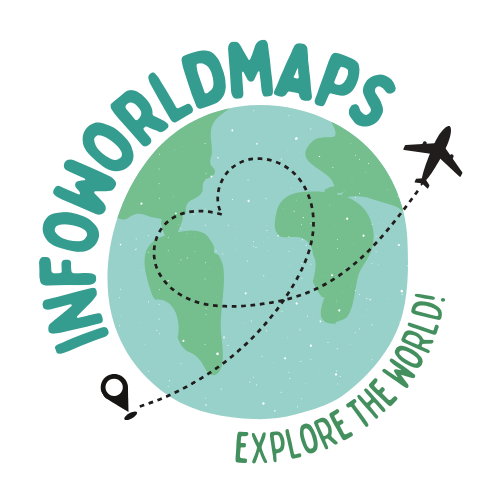Are you searching volcanoes near me? In infoworldmaps.com you can find an interactive map with all volcanoes in world. Here you can see all about volcanoes erupting now around the world.

Interactive 3D map Volcanoes near me
Volcanoes erupting now
In this section you will see the last minute volcanoes anywhere in the world. News and live webcams of the areas affected by volcanic eruptions, as well as interactive maps of the lava flows from the volcano and different current articles on volcanological news, and all volcanoes names.
World Map of volcanoes erupting today
We know of at least 1,500 active volcanoes around the world. That is a big increase from the number that we used to think was correct. It means that more people are searching the earth for them. A graph of the number of volcanoes of the world shows that it goes up just about as fast as the number of people on the earth does. If you want to see a list of volcanoes erupting right now, here you will find it:
Different types of volcanic eruptions
There are several types of volcanic eruption by which volcanologists classify volcanic eruptions. In Infoworldmaps.com we give you all the information related to the types of eruptions.
Volcanoes climate change
The action of volcanoes expels different gases into the atmosphere, including CO2, SO2, H2S, HCl, HF, HBr, OCS and CS2, the first two being the main causes of climate change.
What gases do volcanoes emit?
Inside the crater of a volcano there is nothing alive and many small fumaroles (holes) release nasty gases. There are many colorful minerals being deposited from the gases as they cool. The most important gas is water, and then carbon dioxide. These two important gases are not poisonous. Sulfur dioxide, hydrogen chloride, and hydrogen fluoride are emitted, as well. They are strong poisons and cause pollution problems
There are a lot of volcanoes on earth and we can see in this Interactive 3D map of climate change how volcanoes global warming influence climate change.
Volcanoes facts
Here we highlight several of the main facts about volcanoes:
What country has the most volcanoes?
Indonesia has the most volcanoes, by far. It is really a special place because there seem to be volcanoes all around, in all directions. Merapi (which means “mountain of fire”) erupted in January 1994 and killed a few hundred people.
Which is the biggest volcano?
The biggest volcano in the world is probably Mauna Loa, in Hawaii. It rises off of the seafloor to 13,000 feet above sea level or about 29,000 feet above the seafloor. Another huge volcano is Mt. Etna on the island of Sicily, in Italy.
How old is the oldest volcano?
The oldest volcano is probably Etna and that is about 350,000 years old. Most of the active volcanoes that we know about seem to be less than 100,000 years old. Volcanoes grow because lava or ash accumulates on the volcano, adding layers and height.
How many volcanoes are in the us?
There are about 169 volcanoes in the United States that scientists consider active. Most of these are located in Alaska, where eruptions occur virtually every year.
Volcanoes World 🌎
Here you can see All information about Erupting Volcanoes in the world. Interactive Lava Map Flow, webcam volcano, incredible images and videos and Last News about active Volcanoes, click for More information about Volcano:
- Kilauea (United States)
- La Palma (Spain)
- Pavlof (United States)
- Copahue (Chile-Argentina)
- Rincon de la Vieja (Costa Rica)
- Great Sitkin (United States)
- Semisopochnoi (United States)
- Merapi (Indonesia)
- San Cristobal (Nicaragua)
- Lewotolok (Indonesia)
- Sinabung (Indonesia)
- Karymsky (Russia)
- Sarychev Peak (Russia)
- Sangay (Ecuador)
- Tinakula (Solomon Islands)
- Karangetang (Indonesia)
- Nyamulagira (DR Congo)
- Kadovar (Papua New Guinea)
- Ol Doinyo Lengai (Tanzania)
- Aira (Japan)
- Sabancaya (Peru)
- Ebeko (Russia)
- Nevados de Chillan (Chile)
- Langila (Papua New Guinea)
- Masaya (Nicaragua)
- Tofua (Tonga)
- Pacaya (Guatemala)
- Villarrica (Chile)
- Nevado del Ruiz (Colombia)
- Saunders (United Kingdom)
- Manam (Papua New Guinea)
- Semeru (Indonesia)
- Etna (Italy)
- Bezymianny (Russia)
- Reventador (Ecuador)
- Ibu (Indonesia)
- Popocatepetl (Mexico)
- Suwanosejima (Japan)
- Nyiragongo (DR Congo)
- Fuego (Guatemala)
- Bagana (Papua New Guinea)
- Sheveluch (Russia)
- Erebus (Antarctica)
- Erta Ale (Ethiopia)
- Stromboli (Italy)
- Dukono (Indonesia)
- Santa Maria (Guatemala)
- Yasur (Vanuatu)
Volcanoes and earthquakes
Volcanoes and earthquakes are closely related on earth, if you want to see the latest earthquakes that have occurred around the world you can see it in our interactive map of recent earthquakes.
Top 7 volcanoes
How many volcanoes are in the world?, and are there volcanoes near me?, here you can see best important volcanoes in the world.
1. Volcanoes in Hawaii – Big island
Hawaii is an increasingly popular travel destination that is made up of 8 main islands: Hawaii, Maui, Oahu, Kahoolawe, Lanai, Molokai, Kauai, and Niihau. Each island has special characteristics that make them unique destinations.
The Volcanoes National Park is located about 45 minutes by car from the city of Hilo and was founded in 1916. It is characterized by its extraordinary biodiversity that is spread over its 130 thousand hectares.
Volcanoes to visit in Hawaii – Honolulu:
If you go sightseeing in Hawaii, it is absolutely essential that you visit the Volcanoes National Park, a wonderful place very different from anything you have seen before. In this section you will be able to find all the necessary information about the most interesting places to visit in this corner of Hawaii.
The largest volcano on Earth is Mauna Loa in Hawaii.
The largest volcano on Earth is in Hawaii. It’s called the Mauna Loa. From sea level it is 4,169 metres high. However, under the sea it also goes down another 5,000 metres.Since 1843, it has erupted 33 times.
KILAUEA:
This is undoubtedly one of the most popular places on the island, the one that no traveler wants to miss. But apart from visiting the vicinity of the volcano and enjoying a unique show in the world, it is interesting to visit the museum, where you can learn all the history of this famous volcano.
HALEMAUMAU CRATER:
This will be an interesting spectacle as well: a visit to the steam columns of the huge crater whose interior is known as the home of the volcano goddess Pele. In 1967 this immense crater was filled with lava but over the years it has emptied.
PUU OO VENT:
Kilauea’s lava activity is currently not centered in the caldera, but rather at the top of the volcano. From Puu Oo Vent you will be able to observe different underground lava flood tubes from the Puu Oo that dramatically empty into the sea. Without a doubt, this visit is one of the fundamentals of the park.
how many volcanoes are in Hawaii?
Currently, there are three active volcanoes in Hawaii. On the island of Hawaii, you will find the Maunaloa and the Kilauea in the Hawaii Volcanoes National Park.
The park, as its name suggests, is home to several volcanoes. And although many of them are currently inactive, there are two that are still active: Maunaloa (whose last eruption was in 1984 but is known to be still alive) and Kilaue (which has been erupting since January 1983).
Volcanoes Kauai
Kauaʻi (known as Kauai outside the Hawaiian Islands) is the oldest and the fourth largest of the main islands of the Hawaiian archipelago, with an area of 1,430.43 km². It is also known as “Garden Island” or “Garden Isle”
Volcanoes on Maui
Towering over the island of Maui and visible from just about any point, Haleakala Crater is a force of nature in every sense. At 10,023 feet above sea level, it is a dormant volcano.
2. Volcanoes national park Rwanda
The national park is known as a refuge for mountain gorillas. It is home to five of the eight volcanoes of the Virunga Mountain Range (Karisimbi, Bisoke, Muhabura, Gahinga and Sabyinyo)
3. Volcanoes Costa Rica
Three volcanic mountain ranges cross Costa Rica: the Guanacaste Range, made up of volcanoes of such importance as Arenal or Rincón de la Vieja; the Central Volcanic Range, home to the well-known Poás, Barva, and Turrialba, and the Talamanca Range, which has only one volcano.

- Poás Volcano
Near the city of Alajuela, 20 kilometers west of San José, stands this active volcano whose last eruption was documented in 1953.
- Arenal Volcano
Since in 1968, after more than 500 years of inactivity, the Arenal volcano began to expel lava and ash, it has been considered one of the most active volcanoes in Costa Rica. Also, for this reason, one of its greatest tourist attractions.
- Irazú Volcano
With the highest altitude of all the volcanoes in Costa Rica, the Irazú commands respect with its name alone. The indigenous word Iztarú, from which Irazú derived, meant mountain of tremors.
- Turrialba Volcano
The Turrialba volcano is not very popular with tourists visiting the volcanoes of Costa Rica. In part, due to having to compete with his older brother Irazú, with whom he shares a base. On the other hand, due to its intense volcanic activity, which has motivated the prohibition of accessing it on several occasions. The volcano registered one of its largest eruptions in September 2016, spewing clouds of gases and ash that reached 3,000 meters in height.
- Rincón de la Vieja Volcano
In the province of Guanacaste, 25 kilometers northeast of Liberia, this volcano is surrounded by mysticism and legend. They say that an indigenous princess fell in love with an enemy warrior. The princess’s father, contrary to the relationship, threw the young man into the crater. In order to always be close to him, the princess retired to live next to the volcano and learned to heal with the local plants, a work that she continued also during her old age. For this reason, the local people began to call the volcano the Rincón de la Vieja.
- Barva Volcano
The Barva volcano is part of the Braulio Carrillo National Park, one of the largest in the central area of Costa Rica.
- Tenorio Volcano
Around this volcano, in the north of Costa Rica, stands one of the best kept secrets in the entire country. The Tenorio Volcano National Park, although difficult to access, hides corners of great beauty and is considered a magnificent place to go hiking and get into the wildlife of the area.
4. volcanoes guatemala
In Guatemala there are approximately 288 volcanoes or structures of volcanic origin. Only 8 of these have activity reports in historical times and 3 are the most active today.
Still, 37 are officially recognized as volcanoes by the National Federation of Mountaineering. Instead, the National Geographic Institute recognizes 32.
5. volcanoes in italy
Italy is a volcanically active country, containing the only active volcanoes on the European continent. The country’s volcanic activity is mainly due to the presence, a short distance south of the border between the Eurasian plate and the African plate. The magma erupted by Italian volcanoes is thought to be the result of the upward forcing of molten rock by the subduction of one plate below another.
There are three main groups of volcanism: a line of volcanic centers running northwest along the central part of the Italian peninsula (see Campanian volcanic arc); a cluster in the northeast of Sicily; and another group around the Mediterranean island of Pantelleria.
6. volcanoes in Spain
In Spain, the volcanoes are not very active, since the last Spanish volcano to erupt in Spain was the Teneguía in 1971 and the Tagoro volcano on the island of Hierro in 2011. Despite this, Spain has numerous volcanoes, the Most of them are located in the Canary Islands, these being the only active volcanoes in Spain at present, although we can also find other inactive volcanoes in various parts of our geography.
These are the 10 most important volcanoes in Spain:
- Teide
- Teneguía volcano
- Santa Margarita volcano
- Croscat Volcano
- Tagoro volcano
- Cerro Gordo volcano
- Lanzarote volcanoes
- Hoyazo de Nijar
- Cerro de Agrás volcano
- Cancarix Volcanic Python
7. volcanoes in iceland
Iceland has a high concentration of active volcanoes due to the mid-Atlantic ridge and a hot spot below the island. In Iceland there are approximately 130 active and inactive volcanoes, and under the island, spread throughout the country except in the West Fjords, there are about 30 active volcanic systems.
volcanoes for kids
In this video you can learn a lot about volcanoes for kids. Do you know how Volcanoes Work? What makes Volcanoes Erupt? You can see it and tell us what you think about this website, help us to improve.
You might be interested…
[pt_view id=”c067352iq4″]




Leave A Comment